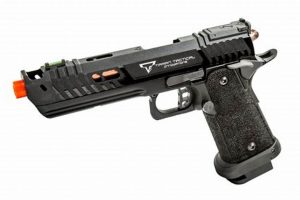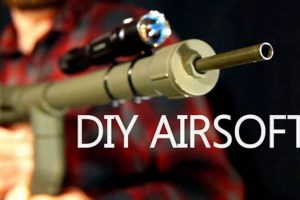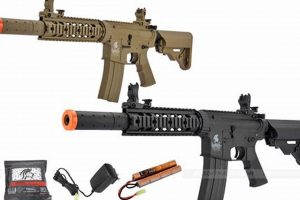The functionality of these recreational devices stems from their capacity to launch non-lethal projectiles, typically 6mm or 8mm plastic BBs, with relatively low energy. This characteristic makes them suitable for simulated combat scenarios where safety is paramount. Examples include tactical training exercises, recreational skirmishes among enthusiasts, and film production where realistic weapon handling is required without the danger of live ammunition.
The value of these implements lies in their ability to provide a realistic training environment for military and law enforcement personnel, allowing them to practice weapon handling, team coordination, and tactical decision-making in a safe and controlled setting. Furthermore, they promote physical activity, teamwork, and strategic thinking among recreational users. Historically, they have evolved from simple spring-powered launchers to sophisticated, gas-powered replicas mirroring real firearms in appearance and operation.
The subsequent discussion will delve into specific applications, ranging from military training to recreational use, highlighting the benefits and limitations associated with each. The analysis will also consider the legal and safety aspects relevant to their use in various contexts.
Guidance on Maximizing the Utility of Airsoft Devices
The effective utilization of airsoft devices necessitates a comprehensive understanding of their capabilities and limitations. The following guidance outlines key considerations for maximizing their potential in various applications.
Tip 1: Prioritize Safety Protocols: Strict adherence to safety guidelines is paramount. This includes mandatory eye protection, awareness of engagement distances, and responsible handling practices. Neglecting safety protocols negates any potential benefit.
Tip 2: Select the Appropriate Equipment: The intended application dictates the optimal device type. For training purposes, realistic replicas may be preferable, while recreational use may warrant prioritizing durability and performance. A informed selection is crucial.
Tip 3: Emphasize Realistic Training Scenarios: When employing them for training, the scenarios should closely mirror real-world situations. This includes incorporating realistic objectives, communication protocols, and tactical considerations. Accurate simulation enhances skill development.
Tip 4: Foster Teamwork and Communication: Airsoft games inherently require collaboration. Encouraging clear communication, coordinated movements, and strategic planning will amplify their benefit as a team-building exercise and tactical teaching tool.
Tip 5: Implement Regular Maintenance: Consistent maintenance is essential for ensuring optimal performance and longevity. Regular cleaning, lubrication, and inspection of internal components are critical to avoid malfunctions during use.
Tip 6: Adhere to Local Regulations: Familiarization with and strict adherence to all local laws and regulations pertaining to the ownership, transportation, and use of these devices are non-negotiable. Legal compliance is a fundamental aspect of responsible use.
Tip 7: Debrief and Analyze Performance: Following training exercises or recreational games, conduct thorough debriefings to identify areas for improvement. Analyzing tactical decisions, communication breakdowns, and equipment performance facilitates continuous refinement.
These guidelines emphasize the importance of safety, preparation, and responsible conduct in leveraging the benefits associated with airsoft devices. Proper planning and execution are crucial for realizing their potential as training tools and recreational activities.
The subsequent sections will explore specific applications of these guidelines, further illuminating the practical considerations involved in their effective deployment.
1. Tactical Training
Airsoft devices, in the context of tactical training, provide a cost-effective and safe means of simulating real-world combat scenarios. This simulation allows military, law enforcement, and security personnel to practice weapon handling, team coordination, and tactical decision-making without the inherent risks associated with live firearms. The primary causal factor in this utility is the non-lethal nature of the projectiles, mitigating the potential for serious injury or death during training exercises. The importance of tactical training, as a component of the purpose of airsoft, rests on the ability to reinforce essential skills in a controlled environment. For example, security firms utilize airsoft simulations to train personnel in close-quarters combat and active shooter response protocols. The practical significance of this understanding is that airsoft provides a tangible, realistic training alternative, resulting in improved preparedness and reduced risk during actual operational deployments.
Further analysis reveals that the utilization of airsoft in tactical training extends beyond simple marksmanship drills. Scenarios can be designed to replicate complex urban environments, requiring trainees to navigate intricate layouts, assess threats, and communicate effectively with team members. The realism afforded by airsoft weaponry encourages engagement and participation, fostering a deeper understanding of tactical principles. Practical applications encompass force-on-force training, hostage rescue simulations, and building clearing exercises. The realistic feedback provided by the devices enhances situational awareness and decision-making under pressure. This is demonstrated in various police departments that implement airsoft for training to improve their performance in real-world situations.
In summary, the tactical training application of airsoft centers on its capacity to create realistic, safe, and cost-effective training environments. The challenge lies in maintaining fidelity to real-world scenarios while ensuring adherence to safety protocols. By fostering tactical proficiency and promoting responsible firearm handling, airsoft contributes significantly to the preparedness of those tasked with protecting and serving communities. This application seamlessly integrates within the broader framework of understanding the many uses of airsoft devices for tactical training and recreation.
2. Recreational Sport
Airsoft, as a recreational sport, offers a combination of physical exertion, strategic thinking, and social interaction. The causal factor in this function is the inherent demand for movement and tactical planning within airsoft games. The non-lethal nature of the projectiles enables participants to engage in simulated combat scenarios, fostering teamwork and strategic decision-making in a dynamic environment. The relative safety of the activity compared to some other contact sports increases its accessibility, appealing to a wide range of individuals. Its importance rests on providing an engaging and stimulating form of exercise that promotes both mental and physical well-being. A prime example is the proliferation of organized airsoft leagues and fields worldwide, where participants gather regularly to compete in structured game formats. The practical significance of understanding this recreational application is its contribution to positive social engagement, improved fitness, and the development of strategic thinking skills, all achieved through a safe and controlled environment. Airsoft can be used as a positive social engagement because friends can engage in the activity together while improving thier skills on the field.
Further analysis reveals that the recreational aspect of airsoft extends beyond simply engaging in simulated combat. The sport fosters a sense of community among participants, with players often forming teams, customizing their equipment, and engaging in post-game discussions to analyze strategies and improve performance. The element of customization, where players can modify and personalize their airsoft devices and gear, adds another layer of engagement and creativity. Practical applications of this recreational function include organized tournaments, scenario games that simulate specific military operations, and casual skirmishes among friends. The diverse range of gameplay options and the community-driven nature of the sport contribute to its appeal and sustained growth. These scenarios are important because it is a great way for family members to come together.
In summary, the recreational sport application of airsoft centers on providing a physically and mentally stimulating activity that fosters teamwork, strategic thinking, and social interaction. The challenge lies in promoting responsible gameplay and ensuring adherence to safety regulations within a self-regulated environment. The understanding of this recreational aspect of airsoft contributes to promoting an active lifestyle and improving coordination of skill sets, while upholding a positive social experience. This seamlessly aligns with the broader understanding of the utility of airsoft in both controlled training and leisure activities.
3. Team Building
Airsoft simulations provide a framework for team-building exercises due to the inherent requirement for collaborative strategy and communication to achieve objectives. The cause lies in the simulated combat scenarios, demanding coordinated movements, resource management, and clear lines of communication among team members. The importance of team building as a component in airsoft lies in its ability to cultivate cohesion, trust, and shared purpose among participants. Corporate retreats and leadership development programs often utilize airsoft to foster these qualities. The practical significance of understanding this aspect resides in the improved interpersonal dynamics, efficient problem-solving, and enhanced productivity that result from strengthened team bonds. A team cannot work efficiently without having the proper communication skills to achieve the end goal.
Further analysis reveals that the team-building element of airsoft extends beyond simply achieving victory in a simulated combat scenario. The activity necessitates individuals to assume specific roles, delegate tasks, and adapt to evolving circumstances. The need for real-time decision-making under pressure reinforces individual accountability and collective responsibility. Practical applications include simulated rescue operations, base defense scenarios, and reconnaissance missions. These situations demand a unified approach, enabling participants to identify strengths and weaknesses within the team dynamic. The importance for team building lies within the process of communication and achieving end goals together.
In summary, the team-building application of airsoft centers on its capacity to facilitate collaboration, communication, and strategic alignment within a group. The challenge lies in designing scenarios that effectively promote these qualities while ensuring inclusivity and respect among participants. Understanding the team-building potential of airsoft contributes to fostering stronger interpersonal relationships, improved communication skills, and enhanced problem-solving capabilities within organizational contexts. This application aligns with the broader utility of airsoft as a tool for skill development and practical application in a controlled environment.
4. Film/Media Props
The use of airsoft devices as film and media props stems from their realistic appearance and safe functionality. The cause of this utility is their ability to replicate the visual aspects of real firearms without the inherent dangers associated with live weapons. The importance of airsoft as film/media props lies in their cost-effectiveness and reduced risk during production. They eliminate the need for expensive blank-firing weapons and the associated safety protocols, providing a viable alternative for filmmakers and media producers on budget constraints. An example is their frequent use in independent film productions and amateur filmmaking, where budget and safety considerations are paramount. The practical significance of this understanding is that airsoft enables more realistic portrayals of firearms in film and media while minimizing potential hazards.
Further analysis reveals that the application of airsoft devices as props extends beyond simple visual representation. Their ability to be modified and customized allows prop masters to create replicas of unique or fictional firearms. Practical applications encompass action films, television series, and video game productions, where realism is crucial for audience immersion. Furthermore, airsoft devices can be used to simulate weapon handling and tactical maneuvers, enhancing the authenticity of action sequences. For example, actors can safely practice weapon deployment and aiming techniques without the risk of accidental discharge. The realistic appearance and functionality of airsoft devices contribute to heightened authenticity and increased viewer engagement.
In summary, the use of airsoft as film and media props centers on their capacity to replicate the visual aspects of firearms in a safe and cost-effective manner. The challenge lies in ensuring responsible handling and storage of these devices on set to avoid confusion with real firearms. Understanding the utility of airsoft in this context contributes to improved realism and reduced risk during film and media production, aligning with the broader application of airsoft for simulation and recreational purposes. The safe usage of airsoft devices can facilitate authentic and high-quality content.
5. Skill Development
The utilization of airsoft promotes the development of several tangible skills. This is fundamentally linked to the inherent demands of the activity. Strategic thinking, tactical planning, and effective communication are all necessary for successful participation. The importance of skill development, as a component, stems from the activity’s capacity to enhance cognitive functions, improve coordination, and foster effective interpersonal communication. Military organizations, for instance, leverage airsoft-based training to sharpen the tactical acumen of their personnel. The practical understanding of this application lies in realizing that participation contributes to demonstrable improvements in decision-making capabilities, spatial reasoning, and team coordination.
Further examination reveals that airsoft engagement fosters improvements in hand-eye coordination, reaction time, and physical fitness. The dynamic nature of the activity requires participants to rapidly assess situations, make split-second decisions, and execute precise movements. Practical applications of this include improving fine motor skills through equipment manipulation and enhancing physical endurance through sustained activity. For example, individuals with sedentary lifestyles may find that participating regularly leads to increased physical stamina and improved reflexes. The process of customizing and maintaining equipment also cultivates mechanical aptitude and problem-solving skills.
In summary, the skill development potential of airsoft rests on its capacity to provide a challenging and engaging environment that fosters cognitive, physical, and social growth. The inherent challenge lies in promoting responsible gameplay and ensuring a focus on skill enhancement rather than solely on competitive outcomes. Understanding this skill development potential can lead to targeted applications in various training and recreational settings, solidifying the value of airsoft as a tool for holistic personal growth.
6. Responsible Recreation
The inherent utility of airsoft devices is intrinsically linked to the concept of responsible recreation. The safe enjoyment of these implements hinges on strict adherence to established guidelines, emphasizing ethical conduct and respect for the sport’s integrity. The causal factor here is the potential for misuse or misinterpretation of airsoft devices as real firearms, necessitating a proactive approach to safety and responsible behavior. The importance of responsible recreation, as a component, is underscored by the need to maintain a positive image for the sport and prevent accidents or legal repercussions. A real-world example involves organized airsoft fields that mandate safety briefings, enforce velocity limits, and require appropriate protective gear to minimize the risk of injury. The practical significance of this understanding lies in ensuring the long-term sustainability and acceptance of airsoft as a legitimate recreational activity. The safe and enjoyable application is completely dependent on responsible behavior.
Further analysis reveals that responsible recreation extends beyond mere adherence to safety rules. It encompasses promoting ethical gameplay, respecting the environment, and fostering a positive community spirit. The concept of fair play dictates that participants acknowledge hits, avoid cheating, and treat fellow players with courtesy and respect. Practical applications include participating in cleanup efforts at airsoft fields, mentoring new players on safety protocols, and actively discouraging unsafe or unethical behavior. Organized airsoft events often incorporate these values into their code of conduct, emphasizing sportsmanship and community involvement. Such behaviors ensure that both participants and spectators understand the guidelines and restrictions of such events.
In summary, the safe enjoyment of airsoft depends on the incorporation of responsible recreational habits. The challenge lies in fostering a culture of responsibility among participants, promoting self-regulation, and ensuring consistent enforcement of safety standards. Comprehending the relationship between the utility of these devices and responsible recreation contributes to enhancing the sport’s reputation, minimizing risks, and fostering a positive community. In doing so, the hobby and industry are able to operate safely and thrive together, while also respecting local and federal laws.
Frequently Asked Questions
This section addresses common inquiries regarding the applications and benefits associated with airsoft devices. The information provided aims to clarify misconceptions and offer a comprehensive understanding of their responsible use.
Question 1: What specific skills can be developed through airsoft participation?
Airsoft engagement fosters the development of strategic thinking, tactical planning, communication skills, hand-eye coordination, and problem-solving abilities. The dynamic nature of the activity requires participants to adapt to changing circumstances and make quick decisions.
Question 2: How do airsoft devices contribute to tactical training for law enforcement or military personnel?
Airsoft simulations provide a cost-effective and safe means of replicating real-world combat scenarios. This allows personnel to practice weapon handling, team coordination, and tactical decision-making without the risks associated with live firearms.
Question 3: What measures ensure responsible airsoft usage?
Responsible airsoft usage entails strict adherence to safety guidelines, including mandatory eye protection, responsible handling practices, and awareness of engagement distances. It also involves respecting the environment and promoting ethical gameplay.
Question 4: How can airsoft be used as a team-building activity?
Airsoft simulations necessitate collaborative strategy and communication to achieve objectives. The activity fosters teamwork, cohesion, and shared purpose as individuals assume specific roles and adapt to evolving circumstances.
Question 5: What are the legal considerations regarding airsoft devices?
Legal regulations vary by jurisdiction. It is imperative to familiarize oneself with local laws regarding the ownership, transportation, and use of airsoft devices. Failure to comply with these regulations may result in legal penalties.
Question 6: How are airsoft devices used in film and media productions?
Airsoft devices serve as cost-effective and safe alternatives to real firearms in film and media productions. Their realistic appearance enhances the authenticity of action sequences while minimizing potential hazards on set.
In conclusion, understanding the multifaceted applications and responsible handling practices of airsoft devices is crucial for maximizing their potential benefits and ensuring their safe and ethical use. Whether it’s tactical training, film production, or team building activities, each application requires careful consideration.
The subsequent section will address the limitations related to airsoft applications.
Utility of Airsoft Devices
The preceding analysis has illuminated the diverse functions of what are airsoft guns good for. Their utility extends across various domains, encompassing tactical training, recreational sport, team building exercises, film and media productions, skill development programs, and contexts of responsible recreation. The benefits derived from their usage are contingent upon strict adherence to safety protocols, ethical conduct, and compliance with relevant legal regulations.
The enduring value of airsoft devices lies in their capacity to provide realistic simulations and engaging activities, fostering skill enhancement and promoting responsible engagement. As these implements continue to evolve, ongoing efforts to enhance safety measures and promote ethical conduct are essential to ensure their continued utility and acceptance in various sectors.






![Airsoft Guns: Can You Kill a Squirrel? [Risks & Laws] Ultimate Airsoft Guide for Beginners, Tactics & Gear Reviews Airsoft Guns: Can You Kill a Squirrel? [Risks & Laws] | Ultimate Airsoft Guide for Beginners, Tactics & Gear Reviews](https://airsoftica.com/wp-content/uploads/2025/11/th-674-300x200.jpg)
